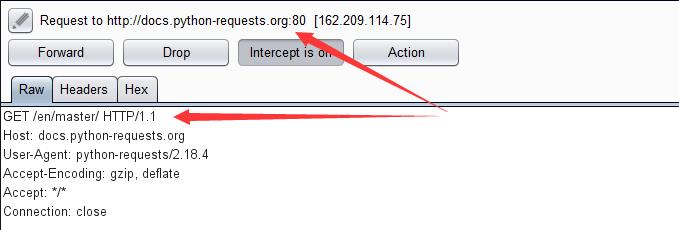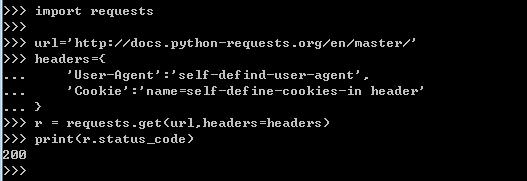python使用requests模块完成get/post/代理/自定义header/自定义cookies
Posted 诸子流
tags:
篇首语:本文由小常识网(cha138.com)小编为大家整理,主要介绍了python使用requests模块完成get/post/代理/自定义header/自定义cookies相关的知识,希望对你有一定的参考价值。
一、背景说明
http请求的难易对一门语言来说是很重要的而且是越来越重要,但对于python一是urllib一些写法不太符合人的思维习惯文档也相当难看,二是在python2.x和python3.x中写法还有差别。
实在是太难用,开始差点由于这个原因想放弃python,直到看urllib.request文档时看到下边这句话,认识了requests。总的而言requests配得上“HTTP for Humans”的口号。

1.1 适用版本
适用于python2.6、python2.7、python3.4及以上版本,参见官方说明。我这里使用的是当前最新的python3.7。
1.2 安装requests模块
pip install requests # ubuntu类系统也可以直接用apt安装 # sudo apt-get install python-requests
二、使用requests模块完成各种操作
下边对于https的链接请求时会带上”verify=False“参数,因为默认Python会进行证书校验如果不是信任的证书会报错,带上”verify=False“指示不进行证书校验。
2.1 引用requests模块
import requests
2.2 get请求
import requests url=\'https://www.baidu.com\' r = requests.get(url,verify=False) print(r.status_code)

2.3 post请求
import requests url=\'https://www.baidu.com\' data=\'username=ls&password=toor\' r = requests.post(url,data=data,verify=False) print(r.status_code)


当前很多api是以json形式提交的,所以在使用post的时候我们可能想提交json数据。
提交json有两步:一是data要编码成json形式(python中的字典形式上和json一样但本质上不一样所以要编码),二是设置“Content-type”头的值为application/json(设置头部参见下面2.5,这里先用)
import json import requests # 一定要设置Content-Type值为application/json headers={} headers[\'Content-Type\']=\'application/json\' url=\'https://www.baidu.com\' data={"username":"ls","password":"toor"} # 一定要用json.dumps把data格式化成json # r = requests.post(url,headers=headers,data=json.dumps(data),verify=False) # 或者直接使用json参数代替data,此时requests会自动进行格式化和设置Content-Type头的工作 r = requests.post(url,json=data,verify=False) print(r.status_code)

为了方便对比验证,另外再附curl post提交的方法:
curl -H "Content-Type:application/json" -X POST --data \'{"username": "ls","password":"toor"}\' https://www.baidu.com/
2.4 使用代理
import requests url=\'http://docs.python-requests.org/en/master/\' proxies={ \'http\':\'http://127.0.0.1:8080\', \'https\':\'http://127.0.0.1:8080\' } r = requests.get(url,proxies=proxies) print(r.status_code)


2.5 自定义header
import requests url=\'http://docs.python-requests.org/en/master/\' headers={ \'User-Agent\':\'self-defind-user-agent\', \'Cookie\':\'name=self-define-cookies-in header\' } r = requests.get(url,headers=headers) print(r.status_code)


2.6 自定义Cookie
实验发现如果自定义header中定义了cookies那么此处设置的cookies不生效
import requests
url=\'http://docs.python-requests.org/en/master/\'
cookies={\'name1\':\'cookie1\',\'name2\':\'cookies2\'}
#cookies=dict(name1=\'cookie1\',name2=\'cookies2\')
r = requests.get(url,cookies=cookies)
print(r.status_code)


2.7 会话保执
经常很多请求只有在登录后才能进行,实现登录效果一般的做法是执行登录请求,然后从返回结果中提取sessionid放入自定义cookie中。
这种方法在requests中也行得通,但requests提供了更为简单的方法,直接使用request.Session类来请求即可,其保持登录的原理是保留之前请求中服务端通过set-cookie等设置的参数。
s = Session() url=\'http://docs.python-requests.org/en/master/\' # 所有方法和直接使用requests时一样用即可 s.get(url)
参考:
http://docs.python-requests.org/en/master/(官方文档)
https://www.cnblogs.com/landhu/p/7048255.html
https://stackoverflow.com/questions/9733638/post-json-using-python-requests
以上是关于python使用requests模块完成get/post/代理/自定义header/自定义cookies的主要内容,如果未能解决你的问题,请参考以下文章